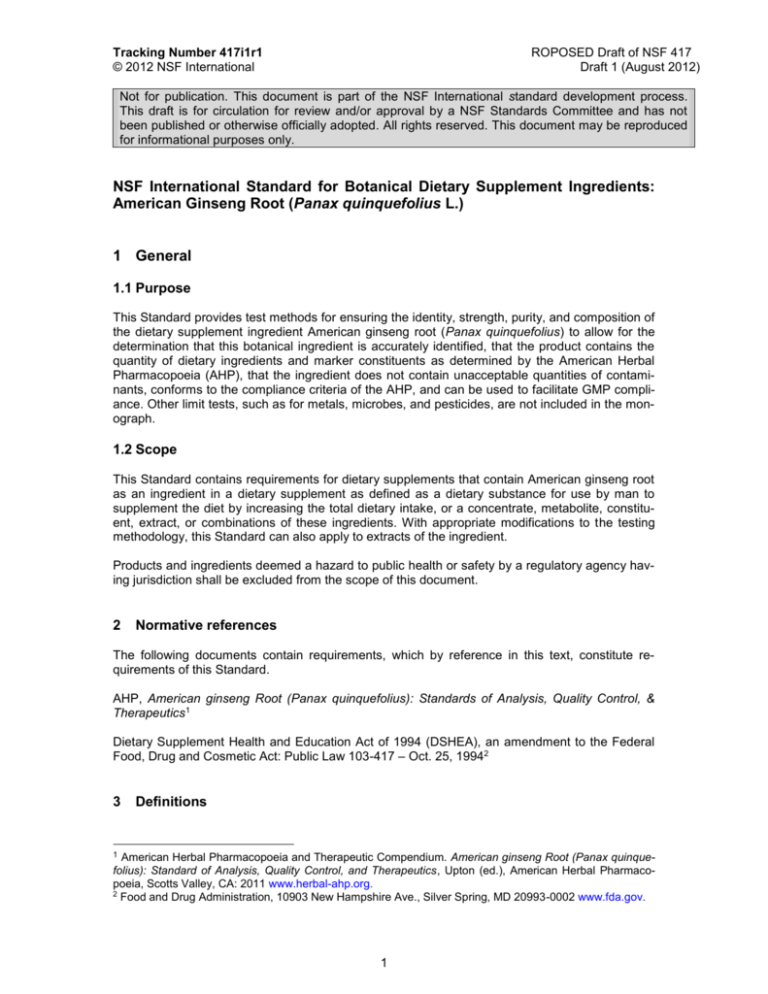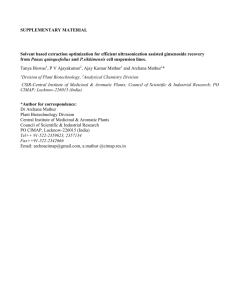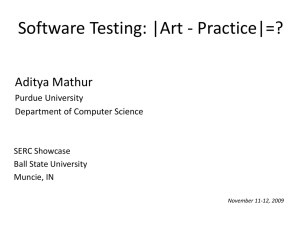
Tracking Number 417i1r1
© 2012 NSF International
ROPOSED Draft of NSF 417
Draft 1 (August 2012)
Not for publication. This document is part of the NSF International standard development process.
This draft is for circulation for review and/or approval by a NSF Standards Committee and has not
been published or otherwise officially adopted. All rights reserved. This document may be reproduced
for informational purposes only.
NSF International Standard for Botanical Dietary Supplement Ingredients:
American Ginseng Root (Panax quinquefolius L.)
1 General
1.1 Purpose
This Standard provides test methods for ensuring the identity, strength, purity, and composition of
the dietary supplement ingredient American ginseng root (Panax quinquefolius) to allow for the
determination that this botanical ingredient is accurately identified, that the product contains the
quantity of dietary ingredients and marker constituents as determined by the American Herbal
Pharmacopoeia (AHP), that the ingredient does not contain unacceptable quantities of contaminants, conforms to the compliance criteria of the AHP, and can be used to facilitate GMP compliance. Other limit tests, such as for metals, microbes, and pesticides, are not included in the monograph.
1.2 Scope
This Standard contains requirements for dietary supplements that contain American ginseng root
as an ingredient in a dietary supplement as defined as a dietary substance for use by man to
supplement the diet by increasing the total dietary intake, or a concentrate, metabolite, constituent, extract, or combinations of these ingredients. With appropriate modifications to the testing
methodology, this Standard can also apply to extracts of the ingredient.
Products and ingredients deemed a hazard to public health or safety by a regulatory agency having jurisdiction shall be excluded from the scope of this document.
2
Normative references
The following documents contain requirements, which by reference in this text, constitute requirements of this Standard.
AHP, American ginseng Root (Panax quinquefolius): Standards of Analysis, Quality Control, &
Therapeutics1
Dietary Supplement Health and Education Act of 1994 (DSHEA), an amendment to the Federal
Food, Drug and Cosmetic Act: Public Law 103-417 – Oct. 25, 19942
3
Definitions
1
American Herbal Pharmacopoeia and Therapeutic Compendium. American ginseng Root (Panax quinquefolius): Standard of Analysis, Quality Control, and Therapeutics, Upton (ed.), American Herbal Pharmacopoeia, Scotts Valley, CA: 2011 www.herbal-ahp.org.
2 Food and Drug Administration, 10903 New Hampshire Ave., Silver Spring, MD 20993-0002 www.fda.gov.
1
Tracking Number 417i1r1
© 2012 NSF International
ROPOSED Draft of NSF 417
Draft 1 (August 2012)
Not for publication. This document is part of the NSF International standard development process.
This draft is for circulation for review and/or approval by a NSF Standards Committee and has not
been published or otherwise officially adopted. All rights reserved. This document may be reproduced
for informational purposes only.
Terms used in this standard that have special meaning are defined here.
3.1 AHP Pharmacopoeial Standard: The primary standard of quality required to meet AHP
compliance.
3.2 Acid insoluble ash: Test designed to detect unacceptable quantities of inorganic matter
(e.g., rock and dirt). The test measures the amount of ash insoluble to diluted hydrochloric acid
according to pharmacopoeial test methodologies.
3.3 Foreign organic matter: Consists of foreign elements of plant origin that are not derived
from the specific plant species and part given in the definition.
3.4 Fracture: The description of the manner in which a root, rhizome, or bark breaks.
3.5 Ginsenosides: Primary constituents of American ginseng presumably associated with its
therapeutic effect.
3.6 Loss of moisture on drying: Test designed to measure the moisture content in a material
according to the specifications of the standard.
3.7 Macroscopic identification: A method of visual assessment based on the gross morphological (macroscopic) and sensory (organoleptic) characteristics of the material.
3.8 Malonylated ginsenosides: Ginsenosides with an additional malonyl residue attached,
which require an additional conversion step to be detected by analytical methods.
3.9 Microscopic identification: A method of assessment based on the identification of the structures and tissues of the plant material using a compound microscope. Requires specialized training.
3.10 Organoleptic characterization: A method of assessment based on the sensory (organoleptic) characteristics of the material including color, taste, smell, texture, etc.
3.11 Total Ash: Test designed to measure the amount of the residual non-organic substances
when a sample is ignited under the conditions specified in the individual monograph or according
to pharmacopoeial test methodologies.
4
Ingredient requirements
4.1 AHP Pharmacopoeial Standard
American ginseng root consists of the dried roots of Panax quinquefolius L. containing not less
than 4.0% total ginsenosides calculated on a dried weight basis.
4.2
Identification
4.2.1
Macroscopic Identification
4.2.1.1 Field-cultivated American ginseng roots
2
Tracking Number 417i1r1
© 2012 NSF International
ROPOSED Draft of NSF 417
Draft 1 (August 2012)
Not for publication. This document is part of the NSF International standard development process.
This draft is for circulation for review and/or approval by a NSF Standards Committee and has not
been published or otherwise officially adopted. All rights reserved. This document may be reproduced
for informational purposes only.
Field-cultivated roots occur in dried form, with the lateral roots removed, or the rootlets (“tails”)
traded alone. Whole field-cultivated roots are 3-20(-24) cm long and 0.5-2.2(-3.4) cm in diameter.
Between the annual aerial stem and the root occasionally present is a slender vertical rhizome
bearing scars from past stems. The number of scars and the length of the rhizome correspond
with the age of the root. Where the rhizome attaches to the root, the root widens abruptly and
becomes ovoid, cylindrical, or spindle-shaped; it is often divided at the base into 2-3 equal
branches. The roots are yellowish-brown to dark brown on the outside, often with vertical creases
and annular wrinkles of various depths that are densest towards the root crown. The fracture is
short and starchy. In cross section, the bark is thin with reddish-brown secretory cavities and the
cortex and stele are a pale yellowish-white with darker annular markings and reddish-brown secretory cavities. The wood is arranged radially, with wide medullary rays. It is light, hard, and
sticky to the touch. The average weight of an individual root is 10-12 g.
4.2.1.2 Woods-grown American ginseng roots
These are generally larger, longer, and thinner than field-cultivated American ginseng, more wrinkled, and with a higher number of branches and rootlets. A typical woods-grown root weighs 6-8
g. Woods-grown roots are almost exclusively sold intact.
4.2.1.3 Wild-simulated American ginseng roots
Wild-simulated American ginseng roots are of varying morphology, depending on the intensity of
the cultivation practices used. The roots range in their characteristics from reminiscent of woodsgrown roots to those that are indistinguishable from true wild roots. Wild-simulated roots are almost exclusively sold intact.
4.2.1.4 Wild American ginseng roots
Wild roots are generally the smallest of the American ginseng roots that are on the market. First
year roots are 25-50 mm in diameter and can double or triple in size in the first few years of
growth until the plant begins to seed, at which time growth slows to about 20% per year. The
roots are yellowish-white to beige, short, squat, fleshy, and spindle-shaped (fusiform), 5-12 cm
long, 1-2.5 cm in thickness, and terminated by one or more stem scars. The roots are often transversely wrinkled and have irregular bumps throughout. Younger roots are round, often with thinner rootlets (tails) emerging, while older roots are often branched, demonstrating the human-like
shape. The cross section of the root shows a hard central portion surrounded by a thick, soft,
white inner cortical layer with thin bark containing numerous reddish resin cells; the wood wedges
are narrow, while the medullary rays are broad. The average weight of wild root is 1.5-2 g. Wild
roots are almost exclusively sold intact.
4.2.1.5 Cut root
Cultivated American ginseng roots are often traded in transversely cut slices and sorted in varying sizes.
4.2.1.6 “Rootlets,” “fiber,” “fibrous roots,” or “parts of root”
The finest fraction of the roots (usually cultivated) that is separated by means of a sieve while
tumbling and consists of pieces of rootlets and ends of main roots 2-25 millimeters long.
3
Tracking Number 417i1r1
© 2012 NSF International
ROPOSED Draft of NSF 417
Draft 1 (August 2012)
Not for publication. This document is part of the NSF International standard development process.
This draft is for circulation for review and/or approval by a NSF Standards Committee and has not
been published or otherwise officially adopted. All rights reserved. This document may be reproduced
for informational purposes only.
4.2.1.7 Powder
Creamy white with flecks of light brown.
4.2.2
Organoleptic Characterization
Aroma: Sweet, spicy, characteristic of plants of the family Araliaceae.
Taste: Faintly aromatic, initially bitter and earthy, then slightly sweet, somewhat gelatinous.
4.2.3
Microscopic Identification
4.2.3.1 Whole root
In transverse section cork thin, composed of thin-walled, regularly arranged parenchyma cells;
phelloderm thin, consisting of tangentially elongated, slightly thickened cells; inside the phelloderm is a layer of parenchyma with no medullary rays; secondary phloem of narrow grey zones
indicating sieve cells and companion cells, separated by broad medullary rays of large roundish
parenchyma cells; secretory ducts up to 80 µm diameter, frequently filled with orange oil droplets
or yellow-brown secretions, are scattered in the cortex and secondary phloem; secondary xylem
of narrow strands of vessels separated by broad medullary rays; vessels up to 50 µm diameter;
primary xylem of small vessels occurs in the center of the root; calcium oxalate cluster crystals up
to 50 µm diameter or occasionally prisms present in parenchyma of all tissues except cork and
phelloderm; fibers and sclereids are lacking throughout. In longitudinal section, vessels with reticulate or scalariform wall thickening. Starch abundant in all parenchyma cells; granules simple or
compound in aggregates of 2-4 granules, individual granules roundish or slightly angular in outline, up to 15 µm diameter; larger granules have a central hilum or slit.
4.2.3.2 Powder
Fragments of cork in surface view; parenchyma cells, some with yellow-brown secretions or calcium oxalate cluster crystals; occasional calcium oxalate prisms; secretory ducts in longitudinal
section, filled with orange-brown secretions; vessels with reticulate or scalariform wall thickenings; starch.
4.3
High Performance Thin Layer Chromatography (HPTLC) for the Identification of American Ginseng Root. Sampling, preparation, and analysis of samples.
4.3.1
Sample preparation
Place 1 g of finely powdered sample in a centrifuge tube, add 10 mL of absolute ethanol, mix
well, and sonicate for 10 minutes. Centrifuge or filter the extract through a syringe filter. The supernatant is the test solution. Liquid extracts can be applied to the plate directly or following appropriate dilution with ethanol.
4.3.2
Standards Preparation (optional
4.3.2.1 Botanical Reference Material
4
Tracking Number 417i1r1
© 2012 NSF International
ROPOSED Draft of NSF 417
Draft 1 (August 2012)
Not for publication. This document is part of the NSF International standard development process.
This draft is for circulation for review and/or approval by a NSF Standards Committee and has not
been published or otherwise officially adopted. All rights reserved. This document may be reproduced
for informational purposes only.
Prepare as sample.
4.3.2.2 Chemical Standards (optional)
Individually dissolve 1 mg of each ginsenoside standard (e.g., Rb , Rb , Rc, Rd, Re, Rf, Rg , Rg ,
and pseudoginsenoside F ) in 5 mL of methanol.
1
2
1
2
11
4.3.2.3 Sulfuric Acid Reagent
Carefully add 20 mL of sulfuric acid to 180 mL of ice-cold methanol. Mix well. Bring to room temperature.
4.3.3
Chromatographic Conditions
4.3.3.1 Stationary Phase
HPTLC plates 10 x 10 cm or 20 x 10 cm silica gel 60 F (Merck or equivalent).
254
4.3.3.2 Relative Humidity
30%-35%.
4.3.3.3 Mobile Phase
Chloroform:ethyl acetate:methanol:water (15:40:22:9).
4.3.3.4 Sample Application
Apply 10 μL of the sample, 10 μL of botanical reference material preparation, or 5 μL of each
chemical standard as 8 mm bands, 2 mm apart from each other. Application position should be 8
mm from the lower edge of the plate and at least 15 mm from the left and right edges of the plate.
4.3.3.5 Development
Line a twin trough chamber with filter paper. Add 10 mL of developing solvent for a 10 x 10 cm
chamber, 20 mL for a 20 x 20 cm chamber, or enough to cover the bottom with a 5 mm level if
using a flat bottom chamber. Let saturate for 20 minutes. Measure and mark the developing distance 80 mm from the lower edge of the plate. Introduce the plate into the chamber with the developing layer towards the inside, close the chamber, and allow the solvent to reach the mark.
Remove the plate and dry for 5 min in a stream of cool air.
Detection
Immerse the plate in sulfuric acid reagent for 1 second or spray the reagent evenly on the plate
surface. Heat to 100 ºC for 5 minutes. Examine the plate under white light and then UV 366 nm.
Table 1 Rf values of standards and corresponding bands in American ginseng root
Observation
5
Approximate Rf value
Tracking Number 417i1r1
© 2012 NSF International
ROPOSED Draft of NSF 417
Draft 1 (August 2012)
Not for publication. This document is part of the NSF International standard development process.
This draft is for circulation for review and/or approval by a NSF Standards Committee and has not
been published or otherwise officially adopted. All rights reserved. This document may be reproduced
for informational purposes only.
a) Sulfuric acid reagent, white light
Ginsenoside Rb1
Ginsenoside Rb2
Ginsenoside Rc
Ginsenoside Re
Ginsenoside Rd
Ginsenoside Rg1
Ginsenoside Rf
Pseudoginsenoside F11
Ginsenoside Rg2
Purple band; typically one of the
strongest
Faint purple band; brightness may
indicate presence of leaf material
Purple band of weak-to-medium intensity
Purple band; typically one of the
strongest
Faint purple band
Purple band; may appear broad in
some samples, especially of wild or
woods-grown roots
Purple band (presence denotes adulteration by other Panax spp.)
Purple band; characteristic of American ginseng
Purple band of weak-to-medium intensity
0.17
0.20
0.24
0.28
0.32
0.37
0.39
0.41
0.44
b) Sulfuric acid reagent, UV 366 nm
Ginsenoside Rb1
Ginsenoside Rb2
Ginsenoside Rc
Ginsenoside Re
Ginsenoside Rd
Ginsenoside Rg1
Ginsenoside Rf
Pseudoginsenoside F11
Ginsenoside Rg2
Thick bluish fluorescent band
Thin bluish fluorescent band; higher
thickness may indicate presence of
leaf material
Thin bluish fluorescent band
Pinkish fluorescent band; particularly
strong in field-cultivated roots
Thin bluish fluorescent band
Pinkish fluorescent band; may be
particularly strong in wild or woodsgrown roots
Thin, pinkish fluorescent band (presence denotes adulteration by other
Panax spp.)
Brownish fluorescent band; characteristic of American ginseng
Thin pinkish fluorescent band
6
0.17
0.20
0.24
0.28
0.32
0.37
0.39
0.41
0.44
Tracking Number 417i1r1
© 2012 NSF International
ROPOSED Draft of NSF 417
Draft 1 (August 2012)
Not for publication. This document is part of the NSF International standard development process.
This draft is for circulation for review and/or approval by a NSF Standards Committee and has not
been published or otherwise officially adopted. All rights reserved. This document may be reproduced
for informational purposes only.
4.4
High Performance Liquid Chromatography (HPLC) for the Determination of
Ginsenosides in American Ginseng Root
4.4.1
Scope and Applicability
This HPLC method is suitable for detecting and quantifying the six ginsenosides compounds
(Rg1, Re, Rb1, Rc, Rb2, and Rd) found in American ginseng raw materials and finished products.
The method has a linear range of 5-131 μg/mL for ginsenoside Rg , 16-396 μg/mL for ginsenoside Re, 39-993 μg/mL for ginsenoside Rb , 6-135 μg/mL for ginsenoside Rc, 7-166 μg/mL for
ginsenoside Rb , and 8-200 μg/mL for ginsenoside Rd.
1
1
2
4.4.2
Sample Preparation
4.4.2.1 Dry Roots
Grind roots to 60 mesh. Weigh approximately 400 mg of powdered root material. Record the accurate weight. Transfer the powder into a 50 mL centrifuge tube. Add 10 mL of 70:30 methanol/water as the extraction solution. Mix the tube for 1 minute on a vortex mixer and then sonicate
for 25 minutes at room temperature. Following sonication centrifuge the tube at 4000 rpm for 5
minutes. Transfer the supernatant into a 25 mL volumetric flask. Add another 10 mL of extraction
solution to the centrifuge tube and mix again for 1 minute then sonicate for 25 minutes. Centrifuge
the tube and transfer the supernatant to the same 25 mL volumetric flask used to collect the first
extract. Extract the sample in the tube one more time with 4 mL of extraction solvent. Mix the tube
again with the vortex mixer for 1 minute and sonicate for 25 minutes. Centrifuge and transfer the
supernatant to the 25 mL volumetric flask. Rinse the sample material in the tube by adding 1 mL
of extraction solvent, mix the tube for 5 minutes on the vortex mixer, centrifuge for 5 minutes, and
transfer the supernatant to the 25 mL volumetric flask. Prepare the flask up to volume with the
70:30 methanol-water solution, cap, and repeatedly invert to ensure complete mixing of the solution.
Hydrolysis Step: Transfer 1 mL of solution into a 2 mL microcentrifuge tube. Pipette 100 μL of 5%
KOH solution into the tube and mix the tube with a vortex mixer for 5 seconds. Allow the tube to
sit for 2 hours at room temperature, protected from direct light. Neutralize the solution by pipetting
100 μL of 14% KH PO solution into the tube and then mixing the tube with a vortex mixer for 5
seconds. Filter approximately 1 mL of the solution into an HPLC vial, using a syringe fitted with a
45-μm PTFE filter, and analyze as per the chromatography method described below.
2
4
4.4.2.2 Powdered Extracts
Follow the steps described above for crude roots using a sample weight of 200 mg. Extracts do
not typically require a hydrolysis step, as conversion of malonylated ginsenosides usually occurs
in the extraction process.
4.4.2.3 Capsules
Weigh and combine the contents of no fewer than 10 capsules. Follow the steps described above
for crude roots using a sample weight of 400 mg for capsules containing root material and a sample weight of 200 mg for capsules containing extract material.
4.4.2.4 Tablets
7
Tracking Number 417i1r1
© 2012 NSF International
ROPOSED Draft of NSF 417
Draft 1 (August 2012)
Not for publication. This document is part of the NSF International standard development process.
This draft is for circulation for review and/or approval by a NSF Standards Committee and has not
been published or otherwise officially adopted. All rights reserved. This document may be reproduced
for informational purposes only.
Weigh and finely powder no fewer than 10 tablets. Follow the steps described above for crude
roots using a sample weight of 400 mg.
4.4.2.5 Liquid Extracts
Liquid extracts can be diluted with the appropriate solvent to the desired concentration and filtered if necessary.
Note: The method has not been validated on liquid extracts.
4.4.3
Standards Preparation
4.4.3.1 Ginsenosides Rb , Rb , Rc, Rd, Re, and Rg Standards
1
2
1
Calculate, based on the stated purity of the standard, the required amount of each ginsenoside
standard to be quantified (Rb , Rb , Rc, Rd, Re, and Rg ) to obtain a concentration of about 1500
μg/mL of each compound when dissolved in 10 mL of solvent. Accurately weigh the calculated
amount of each ginsenoside standard into a separate 10 mL volumetric flask. Bring to half volume
with methanol and mix until the compounds are completely dissolved. Bring to volume using
methanol and mix well to obtain separate 1500 μg/mL standard stock solutions of each ginsenoside. Mixed stock ginsenoside solutions in ampoule form can also be used for quantification and
detection of ginsenosides. Serial dilutions with methanol can be used to prepare the different
mixed standard solutions required. From the stock solutions, prepare calibration curves ranging
10-100 μg/mL for ginsenoside Rg , 20-200 μg/mL for ginsenosides Re, Rd and Rb , 30-300 μg/mL
for ginsenoside Rc, and 50-500 μg/mL for ginsenoside Rb . The first standard dilution can be prepared by transferring 2000 μL of the ginsenoside Rb stock solution, 1200 μL of the ginsenoside
Rc stock solution, 800 μL of the ginsenosides Re, Rd, and Rb stock solutions, and 400 μL of the
ginsenoside Rg stock solution into a test tube and mixing thoroughly. The additional mixed
standard solutions can be prepared via serial dilutions with methanol.
1
2
1
1
2
1
1
2
1
4.4.3.2 Ginsenoside Rf Standard
To prepare ginsenoside Rf standard stock solution, calculate, based on the stated purity of the
standard, the required amount of ginsenoside Rf standard to obtain a concentration of 1000
μg/mL of ginsenoside Rf when dissolved in 10 mL of solvent. Accurately weigh approximately the
calculated amount of the ginsenoside Rf standard into a 10 mL volumetric flask. Bring to half volume with methanol and mix until the compounds are completely dissolved. Bring to volume using
methanol and mix well to obtain separate 1000 μg/mL standard stock solution of ginsenoside Rf.
4.4.4
Chromatographic Conditions
4.4.4.1 Apparatus
HPLC system equipped with an autosampler, binary pump, and diode array detector.
4.4.4.2 Column
Luna, C18(2), 5 μm, 4.5 mm × 150 mm, 100 Å pore size (Phenomenex, Torrance, CA).
8
Tracking Number 417i1r1
© 2012 NSF International
ROPOSED Draft of NSF 417
Draft 1 (August 2012)
Not for publication. This document is part of the NSF International standard development process.
This draft is for circulation for review and/or approval by a NSF Standards Committee and has not
been published or otherwise officially adopted. All rights reserved. This document may be reproduced
for informational purposes only.
Note: In addition to the column used above, an alternative column is the Luna, C18, 2.1 mm x 250 mm, 5 μm
(Phenomenex, Torrance, CA). It is a smaller bore column that only uses approximately 25% of the required
mobile phases of a 4.5 mm column and gives good resolution. Use of alternative columns will result in
changes in the chromatography.
4.4.4.3
Column temperature: 25 °C.
4.4.4.4
Injection volume: 10 μL.
4.4.4.5 Mobile phase (gradient):
0-8 min 24% acetonitrile in H2O;
8-18 min 32% acetonitrile in H2O;
18-25 min 40% acetonitrile in H2O;
25-42 min 48% acetonitrile in H2O;
43-44 min 100% acetonitrile;
44-45 min 24% acetonitrile in H2O.
4.4.4.6 Flow rate
1.5 mL/min.
4.4.4.7 Detection
203 nm (diode array detector).
4.4.4.8 Run time
45 min.
4.4.4.9 Post time
5 min.
4.4.5
Retention Time Ranges (min.)
Ginsenoside Rg1: 16.0-16.4
Ginsenoside Re: 16.5-16.9
Ginsenoside Rf: 26.0-26.2
Ginsenoside Rb1:28.7-28.9
Ginsenoside Rc: 29.0-30.1
Ginsenoside Rb2: 31.3-31.7
Ginsenoside Rd: 34.4-34.8
4.4.6
System Suitability
9
Tracking Number 417i1r1
© 2012 NSF International
ROPOSED Draft of NSF 417
Draft 1 (August 2012)
Not for publication. This document is part of the NSF International standard development process.
This draft is for circulation for review and/or approval by a NSF Standards Committee and has not
been published or otherwise officially adopted. All rights reserved. This document may be reproduced
for informational purposes only.
4.4.6.1 Injection Precision/Sensitivity
The relative standard deviation (RSDr) of the peak area for each targeted ginsenoside, calculated
for three replicate injections of lowest calibration solution, must be 5%.
4.4.6.2 Resolution
Peak resolution between Rg1 and Re must be 1.0 for all chromatograms of standard solutions.
4.4.6.3 Peak Symmetry
A tailing factor (T) < 2 is acceptable.
4.4.6.4 Linearity
The correlation coefficient of the linear regression for each individual ginsenoside must be 0.99.
4.4.6.5 Calculation
The concentration of each ginsenoside (μg/mL) as determined by HPLC is calculated using equation (i):
(i)
(Y-b0)/b1
Where:
Y = the analyte peak area (mAu·s);
b = the calculated intercept of the calibration curve;
b = the calculated slope of the calibration curve.
0
1
The amount of each ginsenoside in the test sample in % (w/w) is calculated using equation (ii):
(ii)
(X*V*D)/(10*W)
Where:
X = the concentration of ginsenoside (μg/mL) determined from equation (i);
V = the final volume of the sample preparation (mL);
D = the dilution factor of the sample preparation;
W = the initial sample weight of the test sample (mg).
Calculate the percentage of total ginsenosides in the sample by adding the percentages of individual ginsenosides.
4.4.7 Species Differentiation
Detection of ginsenoside Rf in an American ginseng sample indicates the potential presence of
other Panax species. Detection of ginsenoside Rf is accomplished by comparison against a ginsenoside Rf calibration standard. Similarly, in American ginseng root, the ratio of ginsenoside
Rb1/Rg1 is typically greater than 10 and in Asian ginseng it is less than 10. These ratios can fluctuate and should not be used as the only marker of differentiation between the species.
4.5
Limit Tests
4.5.1
Foreign matter: Not more than 2.0%.
10
Tracking Number 417i1r1
© 2012 NSF International
ROPOSED Draft of NSF 417
Draft 1 (August 2012)
Not for publication. This document is part of the NSF International standard development process.
This draft is for circulation for review and/or approval by a NSF Standards Committee and has not
been published or otherwise officially adopted. All rights reserved. This document may be reproduced
for informational purposes only.
4.5.2 Total ash: Not more than 8.0%.
4.5.3 Acid insoluble ash: Not more than 5.0%.
4.5.4 Loss on drying: Not more than 10.0% determined when 1.0 g of the pulverized root is
dried at 105 ºC for 2 hours.
4.6
Storage
Follow general guidelines for storage by packing in airtight containers protected from light, heat,
moisture, and insect infestation. Cool temperature storage is recommended.
11









